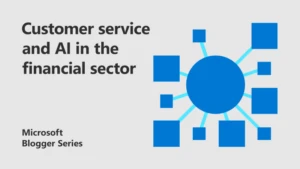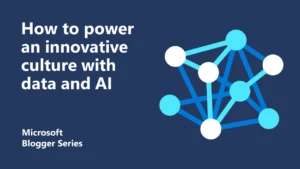
The rise of digital banking: where do we go from here?
Traditional banks have often relied on a strong brand reputation and financial products to attract and retain customers. But with a new wave of youthful and more digitally-savvy consumers emerging, simply being reputable may no longer be enough to stay competitive in this market. Customers are looking for a more flexible and accessible proposition with added-value services that help enrich their lives. This is where digital banking has the advantage.

With less of a product-centric approach, these banks are building innovative cloud-native platforms from the ground up in as little as 12 months. They offer customers an analytical view of their spending habits alongside useful banking features to empower more control of their money.
But even in this space, digital banks are only just scratching the surface. What happens when you start to really understand the behaviour of a customer or business on a transactional level? You open up a wealth of financial and non-financial services that can help improve a customer’s way of life.
Adapting a traditional banking model for the digital consumer
Banks have the ambition to change. However, many are still tied down with high IT operation costs from supporting legacy systems. As a result, we’re increasingly seeing banks across the world looking to ‘create capacity’ and reduce these overheads.
If they can find ways to increase their innovation budgets, traditional banks have a few ways to modernise and keep up with their digital competitors. Right now, we’re seeing three key models being used in this space:
- Leveraging an existing legacy system by adding an API layer to enhance a customer’s digital experience. This allows the bank to integrate with other open banking sources. They can better analyse transactional data to offer more customer-centric features. A faster way to keep pace with other digital banks but ultimately still limited by the legacy.
- Creating a digital sub-brand in the retail space can appeal to anyone looking for a richer banking experience. At the same time, they don’t lose the consumers who still prefer using a trusted provider as their primary account. This does raise an immediate challenge of maintaining two cores – an expensive legacy system with little insight into customer spending habits, and a paralleled digital platform with more discretionary spending but only a small amount of data to target customers with.
- This leads to a third model that we are seeing more and more. Banks building a modular cloud platform to replace their core and take full advantage of the digital space. This approach has more complexity. It requires the new cloud-native system to still support a breath of banking products to maintain the bank’s existing customer base. For a business transformation on this scale, banks should consider simplifying or decommissioning certain financial products in place of new data-driven services. But the outcome will always be a more agile business that has something to offer customers and businesses of all shapes and sizes.
The potential of data-driven and AI banking solutions
By shifting from a product-centric model to one that prioritises customer experience, both traditional and digital banks have more opportunities to support customers in achieving their own personal or business goals.
The key to this is analysing behavioural data and spotting patterns that can prompt a related recommendation or service. In the financial space this could be predicting when a customer may be late paying their bill and reaching out with a solution to extend their credit. Or for non-financial services, like combining a customer’s eco-friendly transactions with smart fitness data to show a holistic view of their carbon footprint.
A second area to consider is how banks could use their partner ecosystem or existing customers to make personalised recommendations for businesses.

Take banks that work with farmers and other agriculture-type services for example. Every year around harvest time they know farmers will request a loan to lease equipment. They use AI to discover the organisations within their customer base that lease farming machinery. Why not approach the farmer with a pre-approved loan when harvest time rolls around and details to connect the two businesses? This turns the whole experience from a product with a transaction rate to a value-added service supplied unexpectedly by the bank.
The goal is to make customers part of the bank’s ecosystem. If the bank can understand what the customer’s products and services are, they can matchmake or connect the customer with opportunities to grow their business. Plus, it ultimately helps the bank grow its own revenue and profit.
Creating a cross-industry banking ecosystem
Transaction data can offer a degree of insight into when, how much and who customers spend money with. But without the SKU level data, banks still don’t know anything about the purchases themselves. Retailers on the other hand are the complete opposite – knowing what they’ve sold but little idea who they’ve sold to.
If banks can create a proposition to bridge that gap. They then can use AI to identify patterns in a customer’s buying behaviour. As a result, they can make personalised recommendations to use partners in the bank’s ecosystem. From special offers on travel insurance for people who fly regularly to recommending eco-friendly brands to sustainable shoppers.
When you consider also the range of customers a bank can have – SMBs, corporate, retailers, manufacturers – this proposition can also go a step further. Banks can connect customer-to-customer and improve the value chain for everyone involved.
Say a farmer produces milk and distributes it to a manufacturer of yogurt and cheese. This is then moved on to a wholesaler and finally the end retailer. If each business was a customer of the bank, they could help remove data silos and interconnect them. This will benefit the entire value chain.
If milk demand rises, the bank can link the manufacturer to more milk farmers in its ecosystem. Or if the farmer has a surplus of milk this month, the bank can recommend other manufacturers to do business with. A smart decision to help accelerate the business’s growth. It also turns the bank from a financial service into an industry partner.
Envisioning the bank of the future

Whatever digital banking model a bank chooses to invest in, it’s essential they first define their new customer journey. This will determine what data, AI and advanced analytics the bank needs to achieve this goal. They can then start looking into partners that can deliver those capabilities.
This is where Microsoft’s ISV partner ecosystem helps digital banks fast track their implementations. Using Azure as a modular platform, new solutions and services can be plugged in as required in ways a more monolithic core banking platform could never do.
It’s important to remember that the success of digital banks isn’t solely down to the fintech or platforms they are using. It is the change of mindset that traditional banks need to embrace – shifting from product-centric thinking to experience-centric action. With that in mind, here’s some things to consider:
- With more and more banks moving into the digital space, make sure you are clear on your digital proposition. What customer needs will it address and how can you achieve this better than other providers?
- When you’re ready to progress, keep in mind that it’s not just the technology that you need to have in place. Your business also needs to rethink how it operates and be willing to make changes to move the organisation forward.
Find out more
Get insight to the latest modernisation strategies in the Digital Banking Playbook 2021
Grow your business with Microsoft Cloud for Financial Services
About the author

Steve is a senior industry architect at Microsoft Industry Solutions, working for the worldwide team. He leads digital transformation for Microsoft’s largest and most strategic Financial Services customers across the globe. He specialises in core banking, payments, and the design and delivery of neo-banks on the Microsoft Cloud platform. Steve has over 25 years of experience in various leadership, architectural and advisory roles. As a result, he has been instrumental in leading banks on their journey to the cloud.




